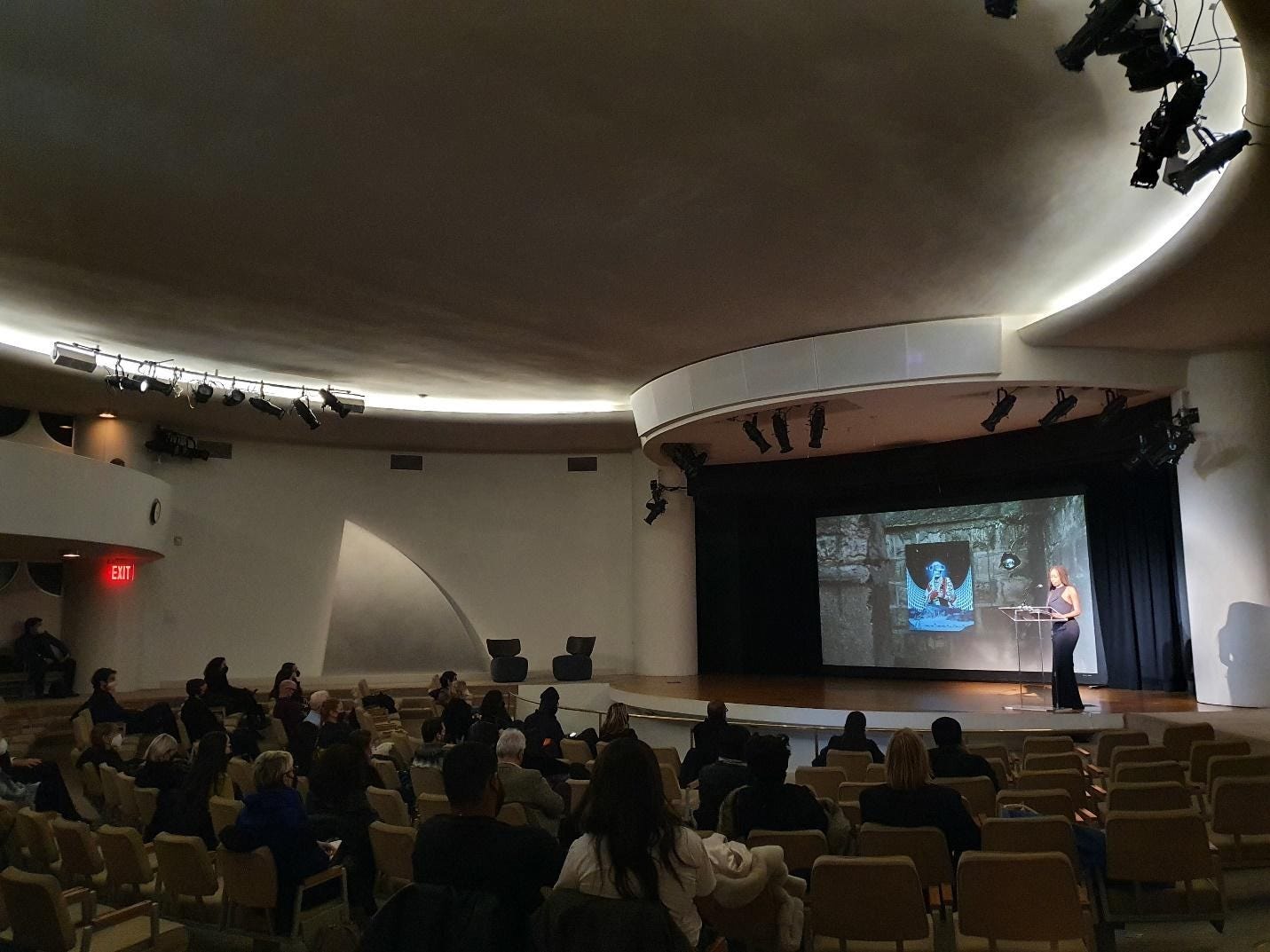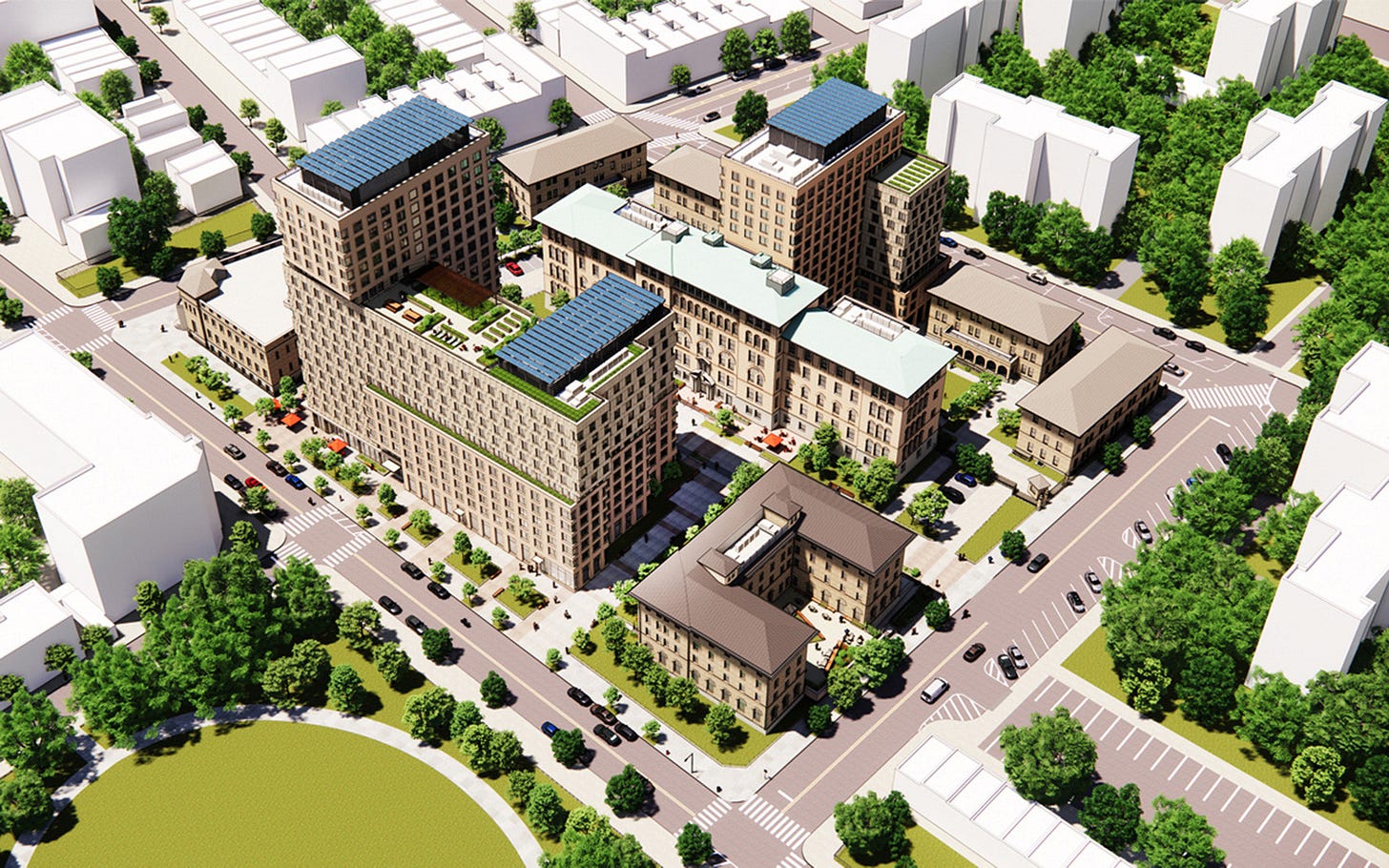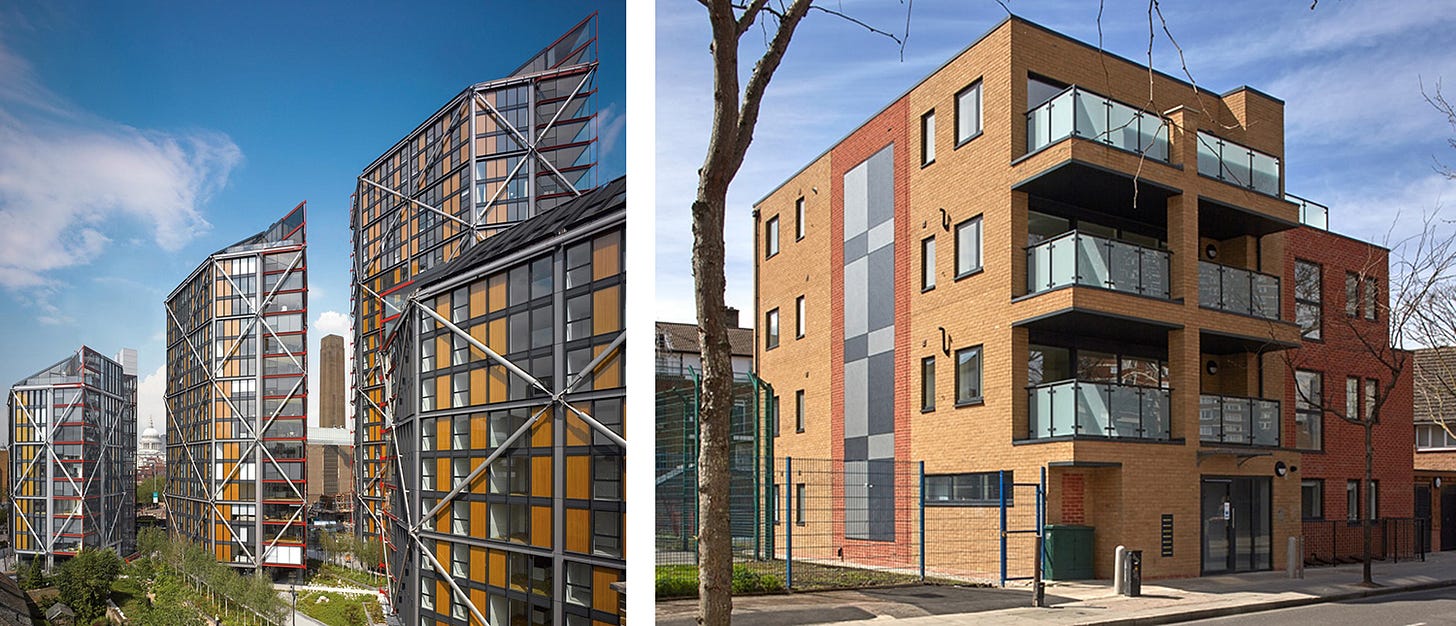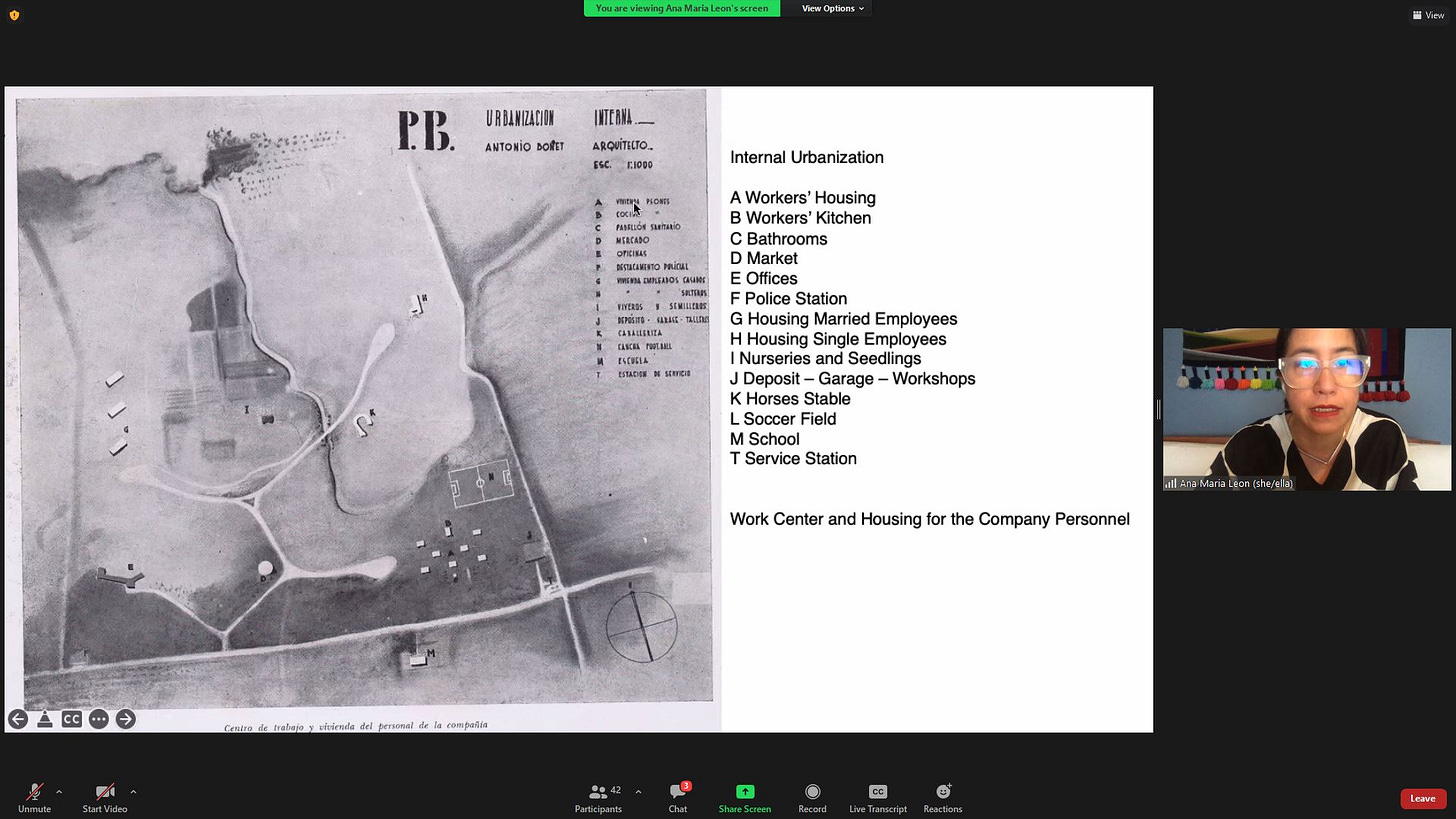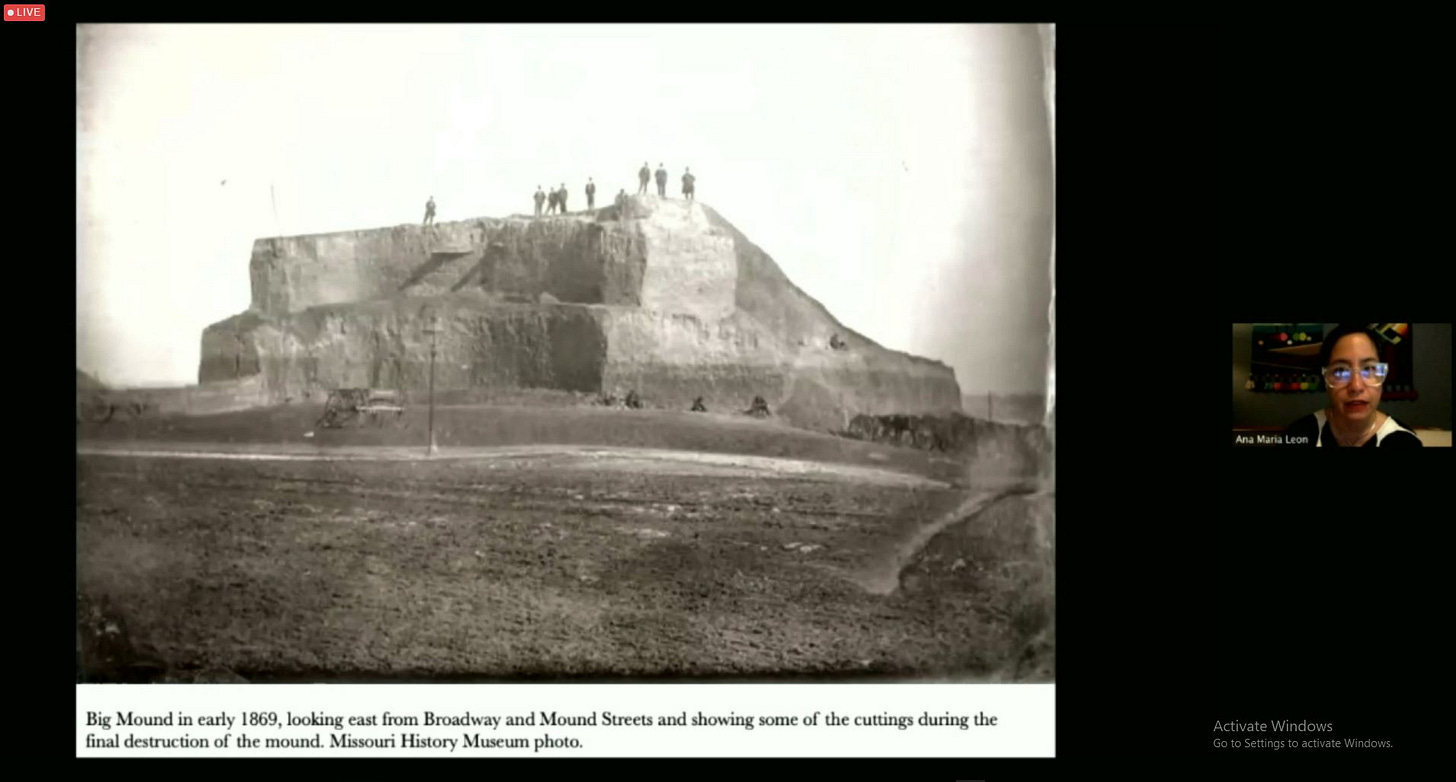Issue 56. If someone forwarded you SKYLINE and you wish they had not because you do not like e-mails, subscribe and read us in print.
Feeling the housing crunch? Home prices are up (and rents too), due in part to increased construction costs resulting from pandemic-related supply chain issues. Giant private equity firms are playing their part by “buying up apartment buildings en masse to squeeze them for profit.” It’s all having an effect: I just saw an ad for a garage in an alleyway here in Toronto for sale for a million dollars, with a warning that it’s suitable only to be torn down to build an accessory dwelling unit—but “think of the possibilities!” Paul Krugman thinks it’s not a bubble.
Since the housing problem doesn’t seem to be going away—and looking forward to the deadline this Sunday for the 100% Affordable 5 WTC call for designs—we are starting this week’s Skyline with a series of capsule reviews of affordable housing projects.
Schools are busily posting their spring events, and Thursdays are packed. The topic of housing continues with a panel discussion today on homelessness at UT Austin. A series of architects make appearances next week, including Zhu Pei at Columbia on Monday, Wolff Architects at the Cooper Union on Tuesday, and Graig Wilkins at Spitzer and Anthony Titus at Harvard on Thursday. There’s also a thread connecting lectures this Wednesday and Thursday on infrastructure (Iñaki Echeverria at Ohio State), climate change (Michael Osman and Kiel Moe at UCLA), thermodynamics (Dorit Aviv at MIT), and big data (Matthew Zook at Berkeley). You could make it to all four if you cleared out your schedule!
— Matthew Allen
WORLD AROUND SUMMIT 2022
Organized by the World Around in partnership with Het Nieuwe Instituut
5 February 2022
Peter B. Lewis Theater, Guggenheim Museum, NY (also online)
The third iteration of The World Around event series sought to reassure designers of the role they can play in today’s proliferating global crises. The self-styled summit, which eschews critique, is more akin to an urbane curatorial platform, with a polished production to boot. That makes it a great fit for the Guggenheim, whose Peter B. Lewis Theater hosted last week’s event. As cofounder BEATRICE GALILEE made clear in her opening remarks, the function of The World Around is, above all, to inspire.
And to overwhelm. A diverse roster of speakers (22 in all) presented work in rapid-fire succession, with established and emerging architects, academics, and the odd interloper or two vying for the audience’s attention: a couple dozen attended in person, with countless more tuning in online. As with past installments, Galilee and cofounder DIEGO MARROQUIN deemphasized organizational criteria in favor of showmanship. Their rolodex is without equal, with DAVID CHIPPERFIELD, WINY MAAS, and LESLEY LOKKO all making appearances. To be sure, airtime was also made available to lesser known but arguably more compelling participants, such as young designer DOMINIQUE PETIT-FRÈRE, the writer AMITAV GHOSH, and fashion activists TOP MANTA.
One could fret about a lack of substance; the presentations had the feeling of advertisements for the intractable problems they claimed to address. But that would be beside the point. Taken as a whole, the event was undeniably powerful, and I found the rich texture of projects to be consistently compelling. Yes, I was at times dazed and confused, and by the end of it, I had a strange feeling of accomplishment. As one does after running a marathon.
— Harish Krishnamoorthy
CAPSULE REVIEWS:
MAKE IT AFFORDABLE
Cooper Park Commons
Finding affordable housing in NYC seems impossible. For the 2019 affordable-housing lottery, 5.9 million applied for 5,650 units. So when there’s vacant land at a former hospital site in East Williamsburg, the community fights to build affordable residential units. The site of Cooper Park Commons, a planned 100% affordable housing development, has a long history of serving underserved industrial populations and now has the potential to provide 557 affordable units and preserve 200 beds in the homeless shelter. The project has been met with unanimous approval by the community board and strong support at public hearings despite some design concerns about the rendering’s large massing compared to adjacent parcels. But in this case standing out isn’t bad—maybe it signals the beginning of a new trend in the supply of affordable housing.
— Poun Laura Kim
Seeing Double: NEO Bankside
On the left is an image of the NEO Bankside development: five towers of 217 luxury units across the street from the Tate Modern. Completed in 2013 by Rogers Stirk Harbour + Partners and a finalist for the 2015 Stirling Prize, from a resident’s front door to St. Paul’s Cathedral is a ten minute walk, and it’s only minutes further to their favorite financial firm’s headquarters in the City of London. And—as the marketing brochure keenly points out—don’t forget about the proximity to tube lines and rail stations, premier venues of culture and offices of government. What more could the intrepid global professional need?
According to a 2006 plan, the Borough of Southwark—in which NEO Bankside sits—required 40% of new housing construction to be affordable, meaning 87 affordable units would be sprinkled into one of the hottest areas in all of London. (For reference, the tallest tower in the left image has 73 units).
On the right is an image of the NEO Bankside development: or, one of the six ‘off-site’ buildings that house its required affordable units. None of them were designed by RSH+P, and none are located a ten minute walk from St. Paul’s or across the street from Tate Modern. Although the developer, Native Land, claims to have ultimately provided 132 affordable units off-site, they’ve been accused of using tricky accounting.
While NEO Bankside’s glossy marketing celebrates the tastes of its would-be residents, the development denigrates those whom they’d rather not be neighbors with. Qualitatively they’re not nearly the same, and the double standard results in class-based spatial segregation. This isn’t about aesthetic moralism. It’s about recognizing the social effects of tactics like these, staying vigilant, and rejecting them outright.
— Nicholas Raap
DISPATCHES
2/4: Community is a Practice
Architectural history has an audio problem. We may want to hear communities, clients, and architects speak in their own voices, but actual audio recordings play a vanishingly small role in the way we learn history. In the sixth issue of the audio journal Attention (edited by historians JOSEPH BEDFORD and CURT GAMBETTA), architectural historian ANNA GOODMAN gets at the crux of the problem through a series of episodes based on oral histories of participatory design. At the launch event at Portland State University, Goodman played clips emerging from the design of a “neighborhood commons” in Philadelphia by landscape architect and activist B. KARL LYNN—a pivotal moment in the evolution of participatory design in the 1960s. The voice of architect SIM VAN DER RYN decrying “the steady destruction of our environments” caught my attention in another episode focusing on Berkley’s People's Park. All together, the journal issue’s four episodes tell a compelling story of genuinely participatory design, which Goodman says has largely been “erased from history—but it didn't die.”
— Matthew Allen
2/7: Modern Settlers: Labor and Leisure in Punta Ballena
“Too often, we see white Europeans, usually male, heteronormative scholars, being cited as part of a canon of theory [pertaining to Latin America],” said architect, historian, and educator ANA MARÍA LEÓN at a Yale Architecture lecture on the topic of labor, leisure, and settler colonialism in Uruguay. “[In looking at Punta Ballena], I wanted to think about what folks closer to these populations (like the Aymara) have thought and how they have voiced their understanding of settler colonialism and indigenous history.”
In the lecture, León looked at three projects in Punta Ballena: Arboretum Lussich, a modernist resort, and a worker’s camp that housed the population that would build the resort landscape. (The last two are by Catalan architect Antonio Bonet.) In discussing the workers’ camp, León said that “understanding who the workers were and where they came from” could bring to light the site’s connection to the settler colonial history of the country. “It is believed that many of them came from Aiguá (the name means running water in Guaraní), and from further north, from Artigas or Rivera, near the border with Brazil,” added León, “[areas of the country] that have higher percentages of [Charrúa, Guaraní], and Afro-Uruguayan populations.” The three projects in Punta Ballena, said León, “operate under an assumption of innocence, a presumed emptiness of the space that preceded them.” Pushing back against such assumptions “opens up frameworks for indigenous futurity.”
— Sebastián López Cardozo
2/8: Enclosure
"Once you've tasted cool air, it is impossible to reverse that. It is an addiction," said the architectural scientist and biomaterials technology researcher MAE-LING LOKKO, delivering a short history of tropical air at the launch for the architect (and spaceport expert) JEFFREY NESBIT's new book Nature of Enclosure. The book, which builds off of an earlier podcast, is a collection of essays that interrogate humanity's megalomaniac obsession with, well, enclosing everything. And then filling it with cool air. At the launch, which was hosted by Cooper Union, several of the authors discussed. After giving a presentation on bubbles ("both emblems of control, and of a hygienic atmosphere"), architect and engineer LYDIA KALLIPOLITI warned against the temptation to see enclosure as a purely technological phenomenon: "I think it is very important to identify this as a cultural problem that has been developing from 19th century greenhouses to corporate towers today." Architect DAISY AIMES reviewed how she is trying to use her office's architectural representation to make the most important things, like airflow, visible. In the question and answer, Cooper Professor (and Carbon Forminista) ELISA ITURBE extended the metaphor to politics, pointing out that the point where two systems meet—precisely where both architecture and politics tries to make it airtight—is often in fact the most productive.
Buy the book!
— Nicolas Kemper
2/9: Sara Bronin
In her lecture at Columbia University, SARA BRONIN spoke of the array of federal, state, and local policies designed since the 1930s to protect communities’ historic fabric against rapid development. The means of historic preservation have often led to unwanted ends. Preservationists have been slow to develop policies for historic structures that address climate change, and some policies even encourage inefficient energy use in the name of preservation. The preservationist impulse sometimes thwarts affordable housing agendas; Bronin sees the complex web of existing regulations as “a thousand cuts” that make new housing nearly impossible, especially in places like Connecticut, where 80% of land is zoned in lots of one acre or larger. But Bronin did not write off historic preservation in exchange for unfettered development, instead advocating for zoning and other policies that can both preserve historic structures in our communities while also ensuring a resilient and equitable future.
— Kevin Ritter
2/9: Destroying the Big Mound
ANA MARÍA LEÓN, in a second event this week, confronted the racist histories of the erasure of the Big Mound. Big Mound was an indigenous burial site and cultural landmark that was part of a larger ceremonial complex of mounds near the Mississippi River. These were significant cultural sites to the Osage and other native peoples who called the area home prior to their forced removal by colonial settlers.
León painted a picture of reverberating violence that began with the seizure and settlement of the Indigenous lands that are now known as St. Louis and continues into the present through the erasures of the history of settler colonialism itself. “By erasing the violent processes that produced them, so-called historic preservation efforts reveal their allegiance to the ongoing processes of settler colonialism,” León said. “Furthermore, the reformulation of sites like Big Mound into easily managed markers… allows the nation state to both strengthen the construct of an imagined community and elide the violence of its construction.”
— Charles Weak
Most Loved Link
The most beloved link in last week’s Skyline was, fittingly, our architecture valentine cards, which are still available, for those who want to show some love for NYRA.
IN THE NEWS
Everyone reacts to the withdrawal of SHoP's unionization effort…
…an historic bridge in Rotterdam is to be dismantled to make way for Bezos’ superyacht…
…new renderings of Two World Trade Center are released…
…a California town wants to be designated cougar sanctuary to avoid housing mandates…
…and a profile of Steven Banks that is actually about expanding New York’s right to shelter into a universal right to housing.
Courtesy Call
Tomorrow is our last day mailing #25 to new subscribers. If you are of the optimizing disposition, now is that time when you can essentially receive an issue for free.
Support our contributors and subscribe at nyra.nyc now, and we will put one in the mail for you.
Otherwise, maybe Thomas Phifer will share one of his copies with you.
DATELINE
Some choices to make on Thursday…
Friday 2/11
We Need to Talk About Homelessness with Joao Paulo Connolly, Dianna Grey, Richard Archer, Sarah Satterlee, Dr. Joe N. Savage, Jr.
2:00 PM Eastern | University of Texas at Austin School of Architecture
Husserl and Spatiality: A Phenomenological Ethnography of Space with Tao Dufour, Lesllie Hewitt, Natalie Melas, Elizabeth O'Donnell, Jorge Otero-Pailos, Anthony Vidler
5:30 PM | The Cooper Union
Monday 2/14
Lecture with Zhu Pei
6:30 PM | Columbia University GSAPP
Tuesday 2/15
Current Work: Wolff Architects with Heinrich Wolff, Ilze Wolff, Mabel O. Wilson, Hayley Eber
12:00 PM | The Architectural League of New York and the Cooper Union.
A Profile of African American Architect Julian Abele: The Shadows are All Mine with David Brownlee, Amy Cohen
Tue, 6:00 PM | Institute of Classical Architecture & Art
Wednesday 2/16
For the Many with Yen Ha
Wed, 12:00 PM | Rice University
Towards Another Architecture with Afaina de Jong
12:30 PM | The Farrell Centre
African Burial Ground National Monument with Nicole Hollant-Denis
6:30 PM | AIA New York
Thursday 2/17
Lunchtime Talks: School or Lab? with Michael Osman, Kiel Moe
3:00 PM Eastern | University of California Los Angeles Architecture and Urban Design
Thermal Architecture with Dorit Aviv
6:00 PM | MIT
Spring 2022 Sciame Lecture Series with Craig Wilkins
6:00 PM | Spitzer School of Architecture
Rupture and Reconciliations with Anthony Titus
6:30 PM | Harvard Graduate School of Design
Frank Lloyd Wright & the Architects of Steinway Hall with Stuart Cohen
7:00 PM | Institute of Classical Architecture & Art
Light's Highest Purpose with Ben Davis
9:00 PM | California College of the Arts
Cities and Technological Imaginaries: Big Data, Fintech and the Limits of Transparency with Matthew Zook
9:30 PM | UC Berkeley College of Environmental Design
LETTERS TO THE EDITOR
Would you like to share your thoughts? Please write to us. Simply reply to this e-mail or write to us at editor@nyra.nyc.
Four desk editors run NYRA: Alex Klimoski, Phillip Denny, Carolyn Bailey & Nicolas Kemper (who also serves as the publisher). They rotate duties each month.
To pitch us an article or ask us a question, write to us at: editor@nyra.nyc.
For their support, we would like to thank the Graham Foundation and our issue sponsors, Tod Williams Billie Tsien Architects and Thomas Phifer.
To support our contributors and receive the Review by post, subscribe here.




